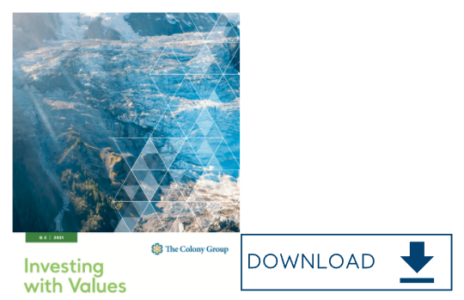Investing with Values: Q2 2021
“Everybody knows that the dice are loaded,
Everybody rolls with their fingers crossed”
Leonard Cohen, “Everybody Knows”
As an avid classic rock fan, I often connect song lyrics or titles to investment topics. Call it a marriage of two topics I love to discuss. While recently listening to one of my playlists and ruminating about the focus of this issue, I was struck by how eloquently the first two lines of Leonard Cohen’s “Everybody Knows” captured the challenges we face and the predicament we are in when it comes to climate change. The recent UN Intergovernmental Panel on Climate Change (IPCC) report was startling in many ways. The report was adamant with its assertion that global warming (greater than previously thought) has been unequivocally human-induced, conclusive on its causes (greenhouse gas, carbon dioxide and methane emissions), and detailed in its effects (too many to list here but think increased flooding, heatwaves, droughts, and frequent extreme or compound weather events). The report also discussed how certain climate-related changes are now irreversible. Michael Mann, the lead author of a previous IPCC report, stated “Bottom line is that we have zero years left to avoid dangerous climate change, because it’s here.” (Earth is warming faster than previously thought, scientists say, and the window is closing to avoid catastrophic outcomes, Angela Fritz and Rachel Ramirez, CNN)
However, while the report was alarming, it afforded glints of optimism. Compared to a similar report from 2013, the worst-case scenario, while still possible, is less likely due to some of the progress we have made reducing emissions over the last several years. The report lays out five scenarios through the end of the century, each with its own emissions pathway. In all five scenarios, global temperatures exceed the 1.5 degrees Celsius threshold above pre-industrial levels recommended by the Paris Agreement in 2015 and quite sooner than previously thought. However, in two of the scenarios, global temperatures peak and then gradually begin to decrease IF we act Now. The report states “From a physical science perspective, limiting human-induced global warming to a specific level requires limiting cumulative C02 emissions, reaching at least net zero C02 emissions, along with strong reductions in other greenhouse gas emissions” (Climate Change 2021, The Physical Science Basis, Summary for Policymakers, IPCC).
Source: Intergovernmental Panel on Climate Change (IPCC)
The good news is that investors can act now and in a variety of impactful ways. Below we provide several recommendations for how one can integrate solutions to this challenge within an investment portfolio. When we discuss the objectives of sustainable investing, we naturally highlight global impact objectives. However, we can’t lose sight of the financial objectives as well-that is, capturing secular opportunities and prudently mitigating investment risks. Our recommendations align with both impact and financial objectives.
Reduce Your Portfolio’s Carbon Footprint
The UN report found that “there is a near-linear relationship between cumulative anthropogenic CO2 emissions and the global warming they cause” and “that reaching net zero anthropogenic emissions CO2 emissions is a requirement to stabilize human-induced global temperature increase.” (UN IPCC report). Thus, investing in a portfolio with a low-carbon footprint is one way an investor can contribute to a more positive emissions scenario. Many sustainable funds will either completely avoid or have limited exposure to fossil fuel companies or other significant carbon emitters. In the Colony Investing Solutions section below, we highlight several environmental impact metrics for representative sustainable portfolios.
Invest in Opportunities and Solutions
Decarbonization, electrification, and adoption of renewable energy have been, and should continue to be, powerful long-term trends. These trends provide attractive investment opportunities. Investors can tilt their portfolios towards companies providing solutions to this energy transition, thereby realizing the dual objective of environmental impact and potentially enhanced long-term returns. In past newsletters, we have emphasized the role thematic funds can play in providing targeted impact. Examples include funds that invest in companies providing solutions for renewable energy and resource efficiency, water access and quality, and renewable infrastructure.
Don’t Forget Fixed Income and Real Estate
Investors can realize environmental impact outside of equites. Many sustainable bond funds invest in green bonds or climate bonds. These fixed income instruments are designed and issued specifically to support climate-related or environmental projects. Examples include a sovereign bond issued to support a country’s sustainability targets or a corporate bond issued to fund that company’s transition to renewable energy. Sustainable bond funds may also deploy carbon-based screens to lower the portfolio’s carbon footprint. Real estate, discussed below in our Trend to Watch section, presents another unique opportunity for environmental impact. Thus, investors can integrate environmental objectives throughout their asset allocation.
Memorize this Equation: Climate Risk=Physical Risk + Transition Risk=Investment Risk
Recently, Taiwan Semiconductor, the world’s largest third-party semiconductor manufacturer, had to resort to trucking in tanks of water to maintain production. The Taiwanese government had to cut water supply to a major chipmaking hub and ration water for over 1 million households. The cause was an extreme weather event, the worst drought in 50 years. Investors should understand that climate risk can affect such variables as economic and corporate profit growth, supply chains, and inflation. Understanding which companies may be more exposed to these risks, and how they are managing them, is essential to building more resilient portfolios. More specifically, we think of physical risk as the risk the location of a company’s assets may pose due to increased flooding, droughts, or other weather events. Transition risk is the legal, regulatory, or market risk a company faces as we transition to a lower-carbon economy.
Sustainable fund managers evaluate these risks in their research and security selection processes. Impax Asset Management, investment adviser to the Pax World funds, has developed a proprietary, physical climate risk model that is used as a tool to analyze a company’s exposure to the physical risk posed by a changing climate. (Impax Asset Management 2021 Engagement Report).
Invest With Fund Managers Who Engage
When it comes to climate change, sustainable fund managers should not only be responsible investors-they should also be responsible owners. This involves proactive outreach and engagement with portfolio companies on material issues related to climate change and the environment. The objectives of engagement are to effect positive change on environmental issues, increase disclosures related to environmental policies, practices, or risks, and ultimately to improve investment decision-making. Examples include working with companies to set renewable energy targets, to commit to decarbonization by adopting the Science Based Targets Initiative, or to link executive pay to specific environmental goals.
As we ponder the present situation, and what we can do to impact the future, can we afford to roll the dice with our fingers crossed? The evidence, both scientific and tangible, suggests we can’t. While many of us have already taken steps to address this challenge in our personal lives, it’s comforting to know we can do the same in our financial lives as well.
Sustainable Investing Trend To Watch: Green Real Estate
Real estate is an asset class that provides a unique opportunity in which to apply an environmental sustainability lens.
Buildings contribute to 40% of global greenhouse gas emissions. With the building stock projected to double by 2050, decarbonizing real estate is imperative to realize the goals set forth by the 2015 Paris agreement to limit further global warming. Several major cities around the world are requiring all new construction to be net zero. This trend presents a variety of potential opportunities for both environmental impact and financial returns. REITs may benefit from reduced operating costs resulting from energy efficiency improvements, higher occupancy rates, and higher rents (often referred to as a “green premium”). Opportunities may also be present in companies providing solutions to decarbonize real estate. Examples include technology companies that provide software used in the design of green buildings, industrial companies that provide energy-efficient HVAC systems, and infrastructure assets such as utilities that provide renewable energy.
SOURCES: New Buildings Institute (World Resources Institute)
For more on Sustainable Investing Solutions, read our primer here or our recent article in Worth magazine here.
Download the PDF version by clicking on the image below.

